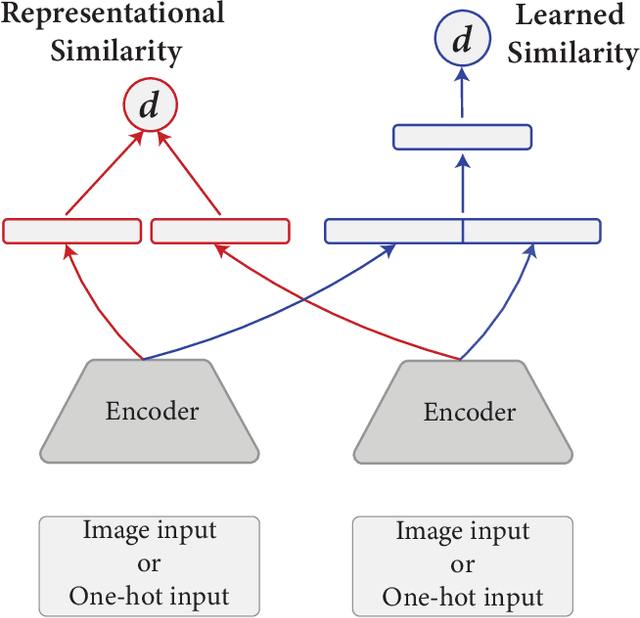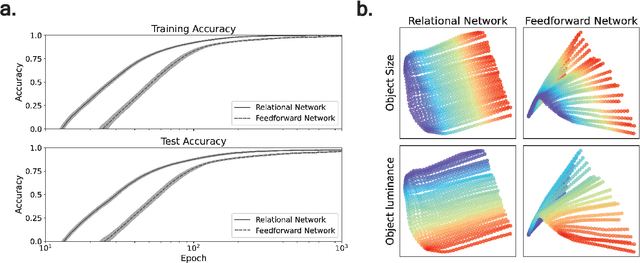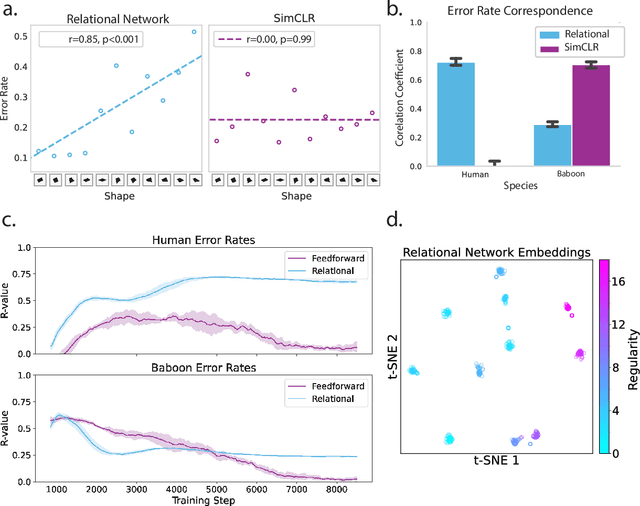Jonathan D. Cohen
AI-enhanced semantic feature norms for 786 concepts
May 15, 2025Abstract:Semantic feature norms have been foundational in the study of human conceptual knowledge, yet traditional methods face trade-offs between concept/feature coverage and verifiability of quality due to the labor-intensive nature of norming studies. Here, we introduce a novel approach that augments a dataset of human-generated feature norms with responses from large language models (LLMs) while verifying the quality of norms against reliable human judgments. We find that our AI-enhanced feature norm dataset, NOVA: Norms Optimized Via AI, shows much higher feature density and overlap among concepts while outperforming a comparable human-only norm dataset and word-embedding models in predicting people's semantic similarity judgments. Taken together, we demonstrate that human conceptual knowledge is richer than captured in previous norm datasets and show that, with proper validation, LLMs can serve as powerful tools for cognitive science research.
Understanding the Limits of Vision Language Models Through the Lens of the Binding Problem
Oct 31, 2024



Abstract:Recent work has documented striking heterogeneity in the performance of state-of-the-art vision language models (VLMs), including both multimodal language models and text-to-image models. These models are able to describe and generate a diverse array of complex, naturalistic images, yet they exhibit surprising failures on basic multi-object reasoning tasks -- such as counting, localization, and simple forms of visual analogy -- that humans perform with near perfect accuracy. To better understand this puzzling pattern of successes and failures, we turn to theoretical accounts of the binding problem in cognitive science and neuroscience, a fundamental problem that arises when a shared set of representational resources must be used to represent distinct entities (e.g., to represent multiple objects in an image), necessitating the use of serial processing to avoid interference. We find that many of the puzzling failures of state-of-the-art VLMs can be explained as arising due to the binding problem, and that these failure modes are strikingly similar to the limitations exhibited by rapid, feedforward processing in the human brain.
Slot Abstractors: Toward Scalable Abstract Visual Reasoning
Mar 06, 2024



Abstract:Abstract visual reasoning is a characteristically human ability, allowing the identification of relational patterns that are abstracted away from object features, and the systematic generalization of those patterns to unseen problems. Recent work has demonstrated strong systematic generalization in visual reasoning tasks involving multi-object inputs, through the integration of slot-based methods used for extracting object-centric representations coupled with strong inductive biases for relational abstraction. However, this approach was limited to problems containing a single rule, and was not scalable to visual reasoning problems containing a large number of objects. Other recent work proposed Abstractors, an extension of Transformers that incorporates strong relational inductive biases, thereby inheriting the Transformer's scalability and multi-head architecture, but it has yet to be demonstrated how this approach might be applied to multi-object visual inputs. Here we combine the strengths of the above approaches and propose Slot Abstractors, an approach to abstract visual reasoning that can be scaled to problems involving a large number of objects and multiple relations among them. The approach displays state-of-the-art performance across four abstract visual reasoning tasks.
A Relational Inductive Bias for Dimensional Abstraction in Neural Networks
Feb 28, 2024



Abstract:The human cognitive system exhibits remarkable flexibility and generalization capabilities, partly due to its ability to form low-dimensional, compositional representations of the environment. In contrast, standard neural network architectures often struggle with abstract reasoning tasks, overfitting, and requiring extensive data for training. This paper investigates the impact of the relational bottleneck -- a mechanism that focuses processing on relations among inputs -- on the learning of factorized representations conducive to compositional coding and the attendant flexibility of processing. We demonstrate that such a bottleneck not only improves generalization and learning efficiency, but also aligns network performance with human-like behavioral biases. Networks trained with the relational bottleneck developed orthogonal representations of feature dimensions latent in the dataset, reflecting the factorized structure thought to underlie human cognitive flexibility. Moreover, the relational network mimics human biases towards regularity without pre-specified symbolic primitives, suggesting that the bottleneck fosters the emergence of abstract representations that confer flexibility akin to symbols.
Human-Like Geometric Abstraction in Large Pre-trained Neural Networks
Feb 06, 2024Abstract:Humans possess a remarkable capacity to recognize and manipulate abstract structure, which is especially apparent in the domain of geometry. Recent research in cognitive science suggests neural networks do not share this capacity, concluding that human geometric abilities come from discrete symbolic structure in human mental representations. However, progress in artificial intelligence (AI) suggests that neural networks begin to demonstrate more human-like reasoning after scaling up standard architectures in both model size and amount of training data. In this study, we revisit empirical results in cognitive science on geometric visual processing and identify three key biases in geometric visual processing: a sensitivity towards complexity, regularity, and the perception of parts and relations. We test tasks from the literature that probe these biases in humans and find that large pre-trained neural network models used in AI demonstrate more human-like abstract geometric processing.
The Relational Bottleneck as an Inductive Bias for Efficient Abstraction
Sep 12, 2023

Abstract:A central challenge for cognitive science is to explain how abstract concepts are acquired from limited experience. This effort has often been framed in terms of a dichotomy between empiricist and nativist approaches, most recently embodied by debates concerning deep neural networks and symbolic cognitive models. Here, we highlight a recently emerging line of work that suggests a novel reconciliation of these approaches, by exploiting an inductive bias that we term the relational bottleneck. We review a family of models that employ this approach to induce abstractions in a data-efficient manner, emphasizing their potential as candidate models for the acquisition of abstract concepts in the human mind and brain.
A Quantitative Approach to Predicting Representational Learning and Performance in Neural Networks
Jul 14, 2023Abstract:A key property of neural networks (both biological and artificial) is how they learn to represent and manipulate input information in order to solve a task. Different types of representations may be suited to different types of tasks, making identifying and understanding learned representations a critical part of understanding and designing useful networks. In this paper, we introduce a new pseudo-kernel based tool for analyzing and predicting learned representations, based only on the initial conditions of the network and the training curriculum. We validate the method on a simple test case, before demonstrating its use on a question about the effects of representational learning on sequential single versus concurrent multitask performance. We show that our method can be used to predict the effects of the scale of weight initialization and training curriculum on representational learning and downstream concurrent multitasking performance.
Systematic Visual Reasoning through Object-Centric Relational Abstraction
Jun 04, 2023Abstract:Human visual reasoning is characterized by an ability to identify abstract patterns from only a small number of examples, and to systematically generalize those patterns to novel inputs. This capacity depends in large part on our ability to represent complex visual inputs in terms of both objects and relations. Recent work in computer vision has introduced models with the capacity to extract object-centric representations, leading to the ability to process multi-object visual inputs, but falling short of the systematic generalization displayed by human reasoning. Other recent models have employed inductive biases for relational abstraction to achieve systematic generalization of learned abstract rules, but have generally assumed the presence of object-focused inputs. Here, we combine these two approaches, introducing Object-Centric Relational Abstraction (OCRA), a model that extracts explicit representations of both objects and abstract relations, and achieves strong systematic generalization in tasks involving complex visual displays.
Determinantal Point Process Attention Over Grid Codes Supports Out of Distribution Generalization
May 28, 2023



Abstract:Deep neural networks have made tremendous gains in emulating human-like intelligence, and have been used increasingly as ways of understanding how the brain may solve the complex computational problems on which this relies. However, these still fall short of, and therefore fail to provide insight into how the brain supports strong forms of generalization of which humans are capable. One such case is out-of-distribution (OOD) generalization -- successful performance on test examples that lie outside the distribution of the training set. Here, we identify properties of processing in the brain that may contribute to this ability. We describe a two-part algorithm that draws on specific features of neural computation to achieve OOD generalization, and provide a proof of concept by evaluating performance on two challenging cognitive tasks. First we draw on the fact that the mammalian brain represents metric spaces using grid-like representations (e.g., in entorhinal cortex): abstract representations of relational structure, organized in recurring motifs that cover the representational space. Second, we propose an attentional mechanism that operates over these grid representations using determinantal point process (DPP-A) -- a transformation that ensures maximum sparseness in the coverage of that space. We show that a loss function that combines standard task-optimized error with DPP-A can exploit the recurring motifs in grid codes, and can be integrated with common architectures to achieve strong OOD generalization performance on analogy and arithmetic tasks. This provides both an interpretation of how grid codes in the mammalian brain may contribute to generalization performance, and at the same time a potential means for improving such capabilities in artificial neural networks.
Learning to reason over visual objects
Mar 03, 2023



Abstract:A core component of human intelligence is the ability to identify abstract patterns inherent in complex, high-dimensional perceptual data, as exemplified by visual reasoning tasks such as Raven's Progressive Matrices (RPM). Motivated by the goal of designing AI systems with this capacity, recent work has focused on evaluating whether neural networks can learn to solve RPM-like problems. Previous work has generally found that strong performance on these problems requires the incorporation of inductive biases that are specific to the RPM problem format, raising the question of whether such models might be more broadly useful. Here, we investigated the extent to which a general-purpose mechanism for processing visual scenes in terms of objects might help promote abstract visual reasoning. We found that a simple model, consisting only of an object-centric encoder and a transformer reasoning module, achieved state-of-the-art results on both of two challenging RPM-like benchmarks (PGM and I-RAVEN), as well as a novel benchmark with greater visual complexity (CLEVR-Matrices). These results suggest that an inductive bias for object-centric processing may be a key component of abstract visual reasoning, obviating the need for problem-specific inductive biases.
 Add to Chrome
Add to Chrome Add to Firefox
Add to Firefox Add to Edge
Add to Edge